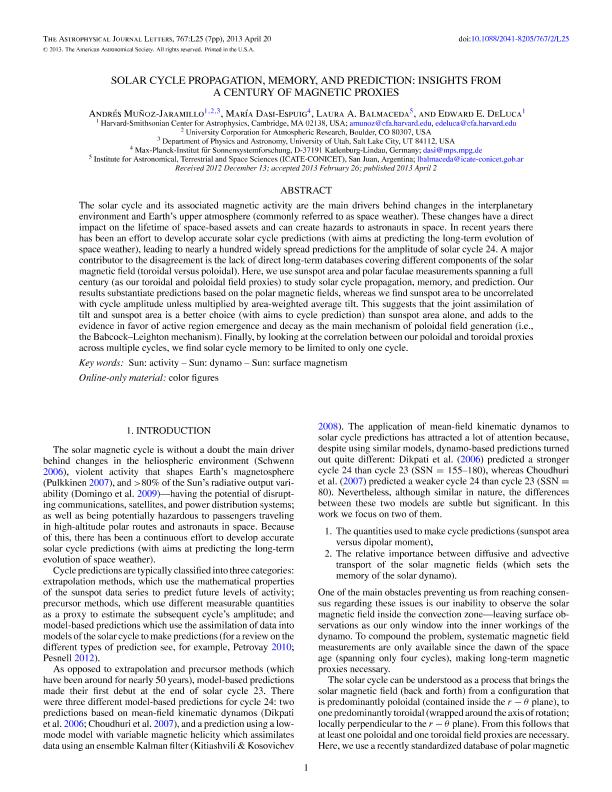Mostrar el registro sencillo del ítem
dc.contributor.author
Muñoz Jaramillo, Andrés
dc.contributor.author
Dasi Espuig, María
dc.contributor.author
Balmaceda, Laura Antonia

dc.contributor.author
Deluca, Edward
dc.date.available
2015-08-12T15:39:34Z
dc.date.issued
2013-04-02
dc.identifier.citation
Muñoz Jaramillo, Andrés; Dasi Espuig, María; Balmaceda, Laura Antonia; Deluca, Edward; Solar Cycle Propagation, Memory, and Prediction: Insights from a Century of Magnetic Proxies; IOP Publishing; The Astrophysical Journal Letters; 767; 25; 2-4-2013; 1-7
dc.identifier.issn
2041-8205
dc.identifier.uri
http://hdl.handle.net/11336/1644
dc.description.abstract
The solar cycle and its associated magnetic activity are the main drivers behind changes in the interplanetary environment and Earth’s upper atmosphere (commonly referred to as space weather). These changes have a direct impact on the lifetime of space-based assets and can create hazards to astronauts in space. In recent years there has been an effort to develop accurate solar cycle predictions (with aims at predicting the long-term evolution of space weather), leading to nearly a hundred widely spread predictions for the amplitude of solar cycle 24. A major contributor to the disagreement is the lack of direct long-term databases covering different components of the solar magnetic field (toroidal versus poloidal). Here, we use sunspot area and polar faculae measurements spanning a full century (as our toroidal and poloidal field proxies) to study solar cycle propagation, memory, and prediction. Our results substantiate predictions based on the polar magnetic fields, whereas we find sunspot area to be uncorrelated with cycle amplitude unless multiplied by area-weighted average tilt. This suggests that the joint assimilation of tilt and sunspot area is a better choice (with aims to cycle prediction) than sunspot area alone, and adds to the evidence in favor of active region emergence and decay as the main mechanism of poloidal field generation (i.e., the Babcock–Leighton mechanism). Finally, by looking at the correlation between our poloidal and toroidal proxies across multiple cycles, we find solar cycle memory to be limited to only one cycle.
dc.format
application/pdf
dc.language.iso
eng
dc.publisher
IOP Publishing

dc.rights
info:eu-repo/semantics/openAccess
dc.rights.uri
https://creativecommons.org/licenses/by-nc-sa/2.5/ar/
dc.subject
Solar Activity
dc.subject
Solar Dynamo
dc.subject
Surface Magnetism
dc.subject.classification
Astronomía

dc.subject.classification
Ciencias Físicas

dc.subject.classification
CIENCIAS NATURALES Y EXACTAS

dc.title
Solar Cycle Propagation, Memory, and Prediction: Insights from a Century of Magnetic Proxies
dc.type
info:eu-repo/semantics/article
dc.type
info:ar-repo/semantics/artículo
dc.type
info:eu-repo/semantics/publishedVersion
dc.date.updated
2016-03-30 10:35:44.97925-03
dc.journal.volume
767
dc.journal.number
25
dc.journal.pagination
1-7
dc.journal.pais
Estados Unidos

dc.journal.ciudad
Washington
dc.conicet.avisoEditorial
©2013. The American Astronomical Society. All rights reserved.
dc.description.fil
Fil: Muñoz Jaramillo, Andrés. Harvard-Smithsonian Center for Astrophysics; Estados Unidos de América;
dc.description.fil
Fil: Dasi Espuig, María. Max-Planck-Institut fur Sonnensystemforschung; Alemania
dc.description.fil
Fil: Balmaceda, Laura Antonia. Consejo Nacional de Investigaciones Científicas y Técnicas. Centro Cientifico Tecnológico - CONICET- San Juan. Instituto de Ciencias Astronómicas de la Tierra y del Espacio; Argentina
dc.description.fil
Fil: Deluca, Edward. Harvard-Smithsonian Center for Astrophysics; Estados Unidos de América;
dc.journal.title
The Astrophysical Journal Letters
dc.relation.alternativeid
info:eu-repo/semantics/altIdentifier/doi/http://dx.doi.org/doi:10.1088/2041-8205/767/2/L25
dc.relation.alternativeid
info:eu-repo/semantics/altIdentifier/url/http://iopscience.iop.org/2041-8205/767/2/L25/pdf/2041-8205_767_2_L25.pdf
dc.relation.alternativeid
info:eu-repo/semantics/altIdentifier/url/http://arxiv.org/abs/1304.3151
Archivos asociados
